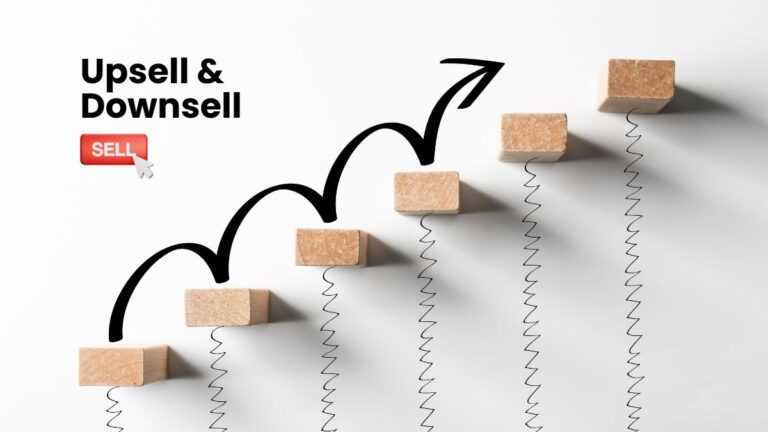Multiple Upsell & Downsell: Finding solutions to boost income and maintain existing client relationships is very essential in the cutthroat environment of contemporary company. You can utilize several upsells and downsells. Within the scope of this in-depth blog article, we will investigate the reasons why your company should think about using these methods, as well as the ways in which they may help you not only improve revenues but also develop closer connections with your customers.
Acquiring Knowledge about Multiple Upsell and Downsell
Before we get into the specifics of the benefits of offering many upsells and downsells, let’s first define what these phrases mean:
Upsells: An upsell is a marketing strategy in which a company offers clients an upgrade to, or a version of, the product or service that they are now contemplating purchasing, or that they have already bought. By highlighting the increased value that clients would have from selecting the more expensive alternative, the objective is to persuade them to spend more money on the product.
Downsells On the other hand, a downsell is a method that you can utilize when a consumer denies the original offer or selects an alternative that is less priced. With a downsell, rather of letting the consumer go without making a purchase, the seller presents an alternate solution or product at a lesser price point. This makes the offer more alluring to the customer and makes it simpler for them to say yes.
Why Should You Use a Variety of Upsells and Downsells?
Now that we’ve discussed what upsells and downsells are, let’s look at some of the reasons why it’s a good idea to include a number of different iterations of these techniques into your company model:
1. Maximizing Revenue: The most obvious advantage of using upsells and downsells is the possibility to raise your revenue. This is one of the most important reasons to apply these strategies. You can capture a larger range of clients and extract more value from each transaction. You can Provide customers with alternatives that are either more costly (referred to as upsells) or alternative, more affordable choices (referred to as downsells) to do this.
2. Increased Customer Lifetime Value (CLV): Both upsells and downsells have a direct influence on the Customer Lifetime Value (CLV) of your business. When you effectively upsell or downsell a customer’s product or service, you deepen their connection with your brand, which ultimately results in increased revenue through repeat purchases and brand loyalty over the long term. If a consumer believes that they are receiving good value from each of their purchases, they are more inclined to continue doing business with that retailer.
3. You can Increase levels of customer satisfaction. You should Offer clients a selection of products or services displays that can comprehend their requirements. Prepare to cater to their individual preferences. This customized strategy has the potential to increase consumer happiness while simultaneously building a favorable impression of your business.
Yoou can use Upsells and downsells to reduce the number of customers that quit their shopping carts. When a consumer has second thoughts about making a purchase on your website or is considering leaving without completing the transaction, giving them with an enticing alternative offer might encourage them to remain on the site and make the buy.
Try Upselling With Exly Now!
5. Two strategies that can assist in improving how inventory is managed are A Better Way to Manage Inventory Upsells and downsells. If you have an excessive amount of a certain product or it is getting close to its expiry date, selling it as a downsell may help you clear out your inventory and reduce your losses.
6. You should establish Trust with your consumers- to accomplish this by offering value on a consistent basis via upsells and downsells. They are more inclined to believe your advice and refer your company to others when they perceive that you sincerely want to assist them in finding the best answer.
7. Gaining an Advantage in the Market Offering both upsells and downsells to customers may provide a business with an advantage in the market. Because many companies ignore these methods, you may differentiate your company from the competition and draw in more clients simply by putting them into practice efficiently.
8. Data Collection and Analysis: You should analyze any significant data Each encounter you have with your consumers, regardless of whether they accept or reject an upsell or downsell. You may acquire insights into client behavior and preferences by studying this data, which will help you to optimize both your marketing strategy and the products and services you provide.
9. Adaptability Having a variety of upsells and downsells at your disposal enables you to be more flexible in response to shifting market circumstances. You are able to modify your offerings in response to input from customers, changes in economic trends, and alterations in consumer behavior.
How to Make Multiple Upsell and Downsells Work for Your Business
Now that we’ve established the advantages of using these tactics, the following steps may help your company efficiently execute numerous upsells and downsells:
1. Get to Know Your Customers In order to successfully upsell or downsell a product or service, you must first get to know your customers and understand their requirements and preferences. You should Make use of consumer data, comments, and surveys. This will develop tailored offerings that are aligned with the interests of the customers.
2. Design Offers That Are Relevant In order to create offers that are relevant to the customer’s first purchase or choice, you must first design upsell and downsell offers. The most important thing is to deliver value and a logical development from the option that they first selected.
3. Timing Is Everything: During the appropriate points in the customer journey, provide upsell and downsell offers to the consumer. This might take place during the checkout process in the case of upsells, or it could take place after a consumer has selected a lower-priced alternative in the case of downsells.
4. Make Sure Each Upsell and Downsell Offer gives actual Value to the consumer Make sure that each upsell and downsell offer gives actual value to the consumer. Bring to light the many positive aspects that come with selecting the other option.
Make Your Analysation Simple With Exly
5. Continuously test a variety of upsell and downsell offers to find which ones connect the best with your audience by using the A/B testing method. Testing your methods using A/B may help you improve them over time.
6. Track and Analyze: Using data analytics, you should monitor and analyze how well your upsell and downsell offers are doing. In order to develop adjustments that are driven by data, pay attention to conversion rates, the amount of income earned, and feedback from customers.
7. Train Your staff:
You should make sure you prepare your staff to properly convey and deliver offers to clients. This is If your upsell and downsell tactics require direct sales or contacts with customer care. This is especially important if your upsell and downsell methods involve direct sales.
8. Be upfront: When offering upsell and downsell alternatives, always be upfront about the price, terms, and restrictions that apply to those options.
9. Experiment with Various Price Points You should try out a variety of price points for your upsell and downsell offers in order to determine the optimal position at which you can maximize income while minimizing the risk of losing clients.
10. Examine and Optimize: On a consistent basis, examine both your upsell and downsell methods in order to locate areas in which you may make improvements. Maintain your flexibility and make any required modifications in response to the ever-shifting dynamics of the market and the actions of your customers.
Success Stories and Other Case Studies
Let’s have a look at a couple of instances from the real world to highlight how powerful it can be to have a variety of upsells and downsells:
1. Amazon.com
Upselling and cross-selling are two types of sales strategies that may be used to increase revenue for a business. When you examine a product on Amazon, you will see a list of other goods that are either connected to the one you are seeing or are commonly purchased together. Customers are encouraged to add more goods to their shopping carts by these recommendations, which ultimately leads to an increase in the total average order value.
2. McDonald’s Restaurants, Inc.
Customers at McDonald’s are presented with the time-honored upselling opportunity of being asked whether they would like to “super-size” their meal. This straightforward inquiry has encouraged many consumers to upgrade their meals, which has directly contributed to the massive fast-food chain’s increased revenues.
The final word
It is possible for your company’s income, level of customer happiness, and long-term performance to be significantly improved if you design your business plan to include several upsells and downsells. You will be able to increase the value of each transaction while simultaneously strengthening your connections with your audience if you take the time to get a knowledge of your clientele, devise appropriate offers, and consistently refine your strategy. If you adopt these techniques, modify them to fit your company’s model, and then sit back and watch as your profit margin expands and your clients become more devoted brand advocates, you will have achieved your goal.





